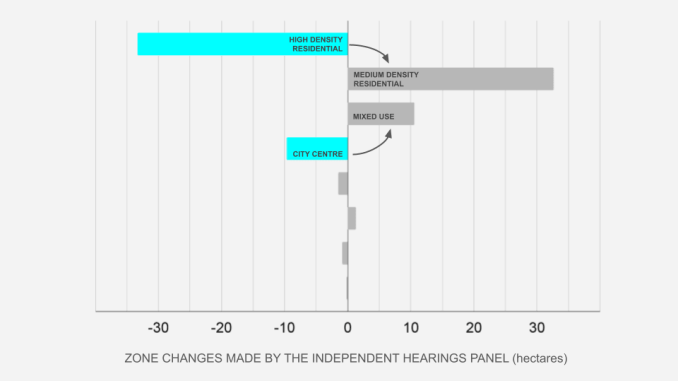
Wellington’s housing panel slashed high-density zoning across the city. These maps showed how much they changed.
The independent hearings panel making recommendations on Wellington’s District Plan slashed the amount of space where it would be legal to build high-density housing (which in most cases means six-storey apartments).
The panel repeatedly justified its decision by saying Wellington already had excess capacity, so cutting high-density zoning would make no difference. But the panel’s reports never offered any calculation of how much space it had downzoned, or how much potential new housing it had eliminated.
In total, 33 hectares of high-density zones have disappeared, replaced by medium-density zoning. The panel scrapped another 10 hectares of the city centre zone, replaced by a mixed use zone.
The high-density changes are not the full extent of the panel’s housing reductions, but are some of the most significant. These maps only show density shrink compared to the council’s draft District Plan. They do not include the many requests for upzoning that the panel rejected throughout the hearing process.
As shown here, most of the cuts are in the inner residential suburbs on the fringes of the city centre.
There’s also one interesting thing that’s not changing. In the middle of the map above is a large slab of land with a cross-hatch pattern. Those 36 hectares between the Basin Reserve and the hospital cover Government House, Wellington College and Wellington East Girls’ College. They’re zoned as high-density residential. This is land that’s highly unlikely to be developed into housing, unless the governor-general is planning on moving to the sleep-out. So planners are working on the assumption that the city has more land available for high-density housing than it actually does.
Johnsonville
The centre of Johnsonville will be zoned for high density because it is a metropolitan centre, but the panel shaved off some bits around the edges. The panel said it would be “fallacious” to allow a walking catchment to the east of State Highway 1, even though there is a pedestrian underpass. It decided the west of Johnsonville wasn’t walkable due to a hill.
Not shown on this map are the density changes due to the panel deciding the Johnsonville train was not “mass rapid transit”. The changes don’t affect the Johnsonville town centre, but had the train been considered mass rapid transit, it would have allowed high-density zoning within a five-minute walk of each of the six stops along the line.
Newtown
Newtown got hit by a double whammy of reduced density.
The panel reduced the size of the city centre walking catchment to stop at John Street (by the Woolworths) instead of extending to Constable Street. It means the whole of Newtown is now excluded from the catchment, which would have allowed high-density zoning by default.
It also more than doubled the area of Newtown covered by character protections, from 25 hectares to 60 hectares, which chopped away even more of the high-density zone.
The city fringe
The panel expanded character areas in Mount Victoria, Thorndon, Kelburn, Lower Kelburn, Aro Valley, Berhampore, The Terrace, Holloway Road, Mount Cook, and Newtown.
Mount Victoria, on the right of the map, shows one of the most dramatic changes. The character area more than doubled in size from 18 hectares to 36 hectares, covering almost the entire suburb. (Not all of these sites were previously zoned for high density.)
On the other side of town, Aro Valley’s character areas tripled in size, from seven hectares to 22 hectares. Mount Cook, at the bottom of the map, went from 11 hectares to 22 hectares.
The source material for these maps are available on Github.
Tim McNamara runs a global technology consultancy called Accelerant from Wellington. Accelerant advises clients on creating software that’s reliable, secure and energy efficient. Contact him at tim@accelerant.dev.
This story first appeared on Radio Today
